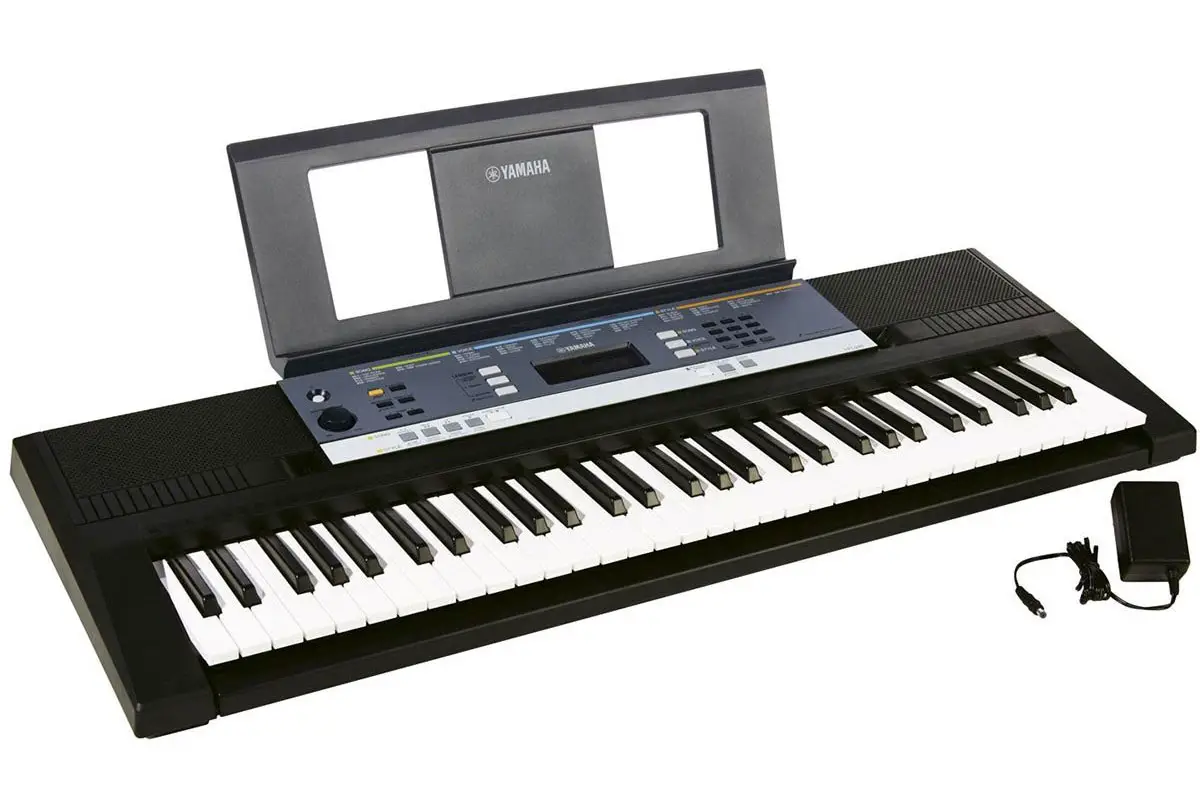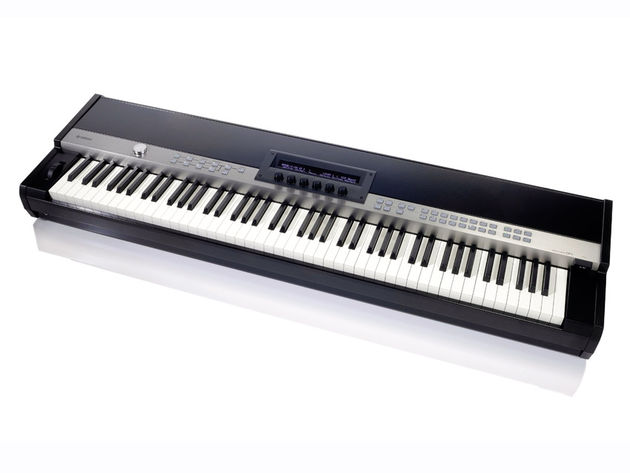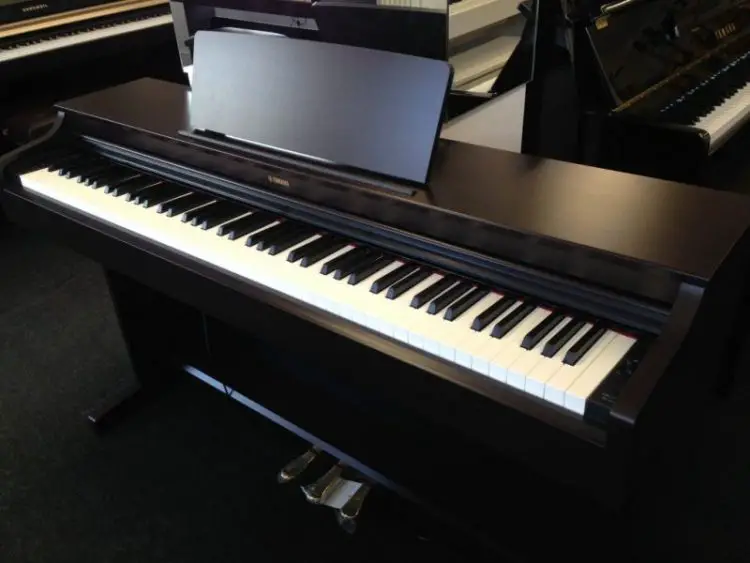
The Yamaha PSR E363 61-Key Touch Sensitive Portable Keyboard is a beginner keyboard with onboard lessons that makes learning to play the piano fast and easy.
It’s also packed with digital capabilities and advanced functions that allow a beginner to create songs, sounds, and compositions that go well beyond most beginner keyboards. It’s an excellent keyboard for the next generation of digital musicians. In this detailed Yamaha PSR-E363 review we will take at at different features, specifications, FAQs and Pros & Cons of this keyboard.
Table of contents
- Overview of Yamaha PSR-E363
- Video Overview of Yamaha PSR-E363
- FAQs of Yamaha PSR-E363
- Specifications of Yamaha PSR-E363
- Who the Yamaha PSR-E363 is Most Suitable For?
- What’s Included in the Box?
- Features of Yamaha PSR-E363
- Pros & Cons of Yamaha PSR-E363
- Yamaha PSR-E363 Manual
- Yamaha PSR E363 vs E463
- Advantages of the Yamaha PSR-E463 over the PSR-E363
- Yamaha PSR-E363 Demo by Lorenzo Perez
- Kevys Rc & Music’s Yamaha PSR-E363 Review
- Summary
Overview of Yamaha PSR-E363

The piano has become a wonderfully versatile musical instrument. Today’s piano is not just an instrument for concert halls and cathedrals, but, with the huge range of instrument voices, rhythms, and effects, it can be the driving sound for any kind of ensemble performance, or allow a single musician to create multi-instrument soundscapes by themselves. Learning to play the piano unlocks a whole world of musical possibilities.
This 61-Key Touch Sensitive Portable Keyboard is designed for the next generation of musicians, with the sound of a portable grand piano, and so much more.
Video Overview of Yamaha PSR-E363
Here’s a two-minute overview, produced by Yamaha:
FAQs of Yamaha PSR-E363
This model came out in 2017.
The keyboard is 94.5 cm long, 11.8 cm high and 36.8 cm wide.
The Yamaha PSR-E363 is 4.6 kg, excluding batteries.
It currently costs approximately $185 online.
61 keys.
574 instrument sounds.
To see a demo, please refer to this Yamaha PSR-E363 demo.
Please see this Yamaha PSR-E363 unboxing.
The cheapest place to buy the Yamaha PSR-E363 is Amazon.
Both the Yamaha YPT-310 and PSR-E363 have 61 keys, easy Song Book (via web download) and touch-responsive keyboard. YPT-310 is slightly bigger and heavier than PSR-E363.
The features of YPT-310 have less variety, including but not limited to the following:
– PSR-E363 has Master EQ effect, while YPT-310 does not.
– YPT-310 has 482 instrument sounds, while PSR-E363 has 574 instrument sounds.
– YPT-310 has 106 auto accompaniment styles, while PSR-E363 has 165 auto accompaniment styles. PSR-E363 also has 150 different arpeggio types.
– YPT-310 has 102 preset songs, while PSR-E363 has 154 preset songs.
– YPT-310 has 32-note polyphony, while PSR-E363 has 48-note polyphony.
– YPT-310 has Yamaha Education Suite, while PSR-E363 has “Keys to Success” and Phrase Repeat on top of Yamaha Education Suite.
– YPT-310 has bass ports for powerful bass sound reproduction, while PSR-E363 does not.
– YPT-310 has 16-part multi timbrel, while PSR-E363 does not
Both the Yamaha PSR-E263 and PSR-E363 have 61 keys, easy Song Book (via web download), Master EQ effect and Duo mode function. PSR-E263 is cheaper, slightly smaller and lighter than PSR-E363.
The features of PSR-E263 have less variety, including but not limited to the following:
– PSR-E363 has touch-responsive keyboard, while PSR-E263 does not.
– PSR-E263 has 400 instrument sounds, while PSR-E363 has 574 instrument sounds.
– PSR-E263 has 130 auto accompaniment styles, while PSR-E363 has 165 auto accompaniment styles. PSR-E363 also has 150 different arpeggio types.
– PSR-E263 has 112 preset songs, while PSR-E363 has 154 preset songs.
– PSR-E263 has 32-note polyphony, while PSR-E363 has 48-note polyphony.
– PSR-E263 has Yamaha Education Suite, while PSR-E363 has “Keys to Success” and Phrase Repeat on top of Yamaha Education Suite.
– PSR-E263 has Ultra-wide Stereo, while PSR-E363 does not.
The Yamaha PSR-E363 has 2.5 W amplifiers while the PSR-E463 has 6 W amplifiers. Therefore, the PSR-E463 can produce fuller and richer sounds.
When the keys are pressed, the Yamaha PSR-E363 gives off louder and harsher clicking sounds than PSR-E463. However, this should not affect recording as the clicking sounds will not be recorded.
Specifications of Yamaha PSR-E363
| Specification | Description |
| Keys | 61 touch-sensitive keys |
| Weight | Weighs just over 10 lbs without batteries |
| Display | Backlit LCD display |
| Songs | 154 preset songs, including touch tutor, chord study, and chord progression practice songs |
| Reverb Settings | 12 levels of reverb |
| Polyphony | 48 max levels of polyphony |
| Style Control | 165 built in styles with style control |
| Harmony | 26 types of harmony |
| Voice & Effects | 574 total instrument voices, with 197 panel voices, 18 drum and effects kits, 20 arpeggio voices, and 339 XGlite voices, 5 types of chorus. |
| Functions | – Dual keyboard function – Split keyboard function – Duo keyboard function |
| Jacks & Ports | – Headphone jack – Sustain pedal jack – AUX IN stereo mini jack – USB to HOST port |
| Record and Playback | Record and playback up to 5 songs with 2 tracks each with onboard memory |
| Music Database | 158 music database |
| Power | AC or DC powered with 6 AA batteries |
| Metronome | Yes |
Who the Yamaha PSR-E363 is Most Suitable For?

Yamaha makes a number of entry-level 61-key keyboards with different feature configurations. They are always highly praised by instructors and experts for their high-quality Yamaha sound and construction.
Piano beginners, particularly older ones, prefer Yamaha’s entry-level keyboards for the same reason: they aren’t toys, and don’t look like toys. They are serious instruments, with the look, sound, and feel of adult musical instruments, that have onboard educational and learning tools.
The PSR-E363 has a much wider range of instrument voices, accompaniment styles, and sound customization effects than many of their entry-level keyboards. It also has touch-sensitive keys, where the volume of a note is affected by the pressure of your fingers. However, it doesn’t have weighted keys – where the keys are harder to press depending on the lowness of the note.
Weighted keyboards simulate the amount of pressure required to move the hammers on an acoustic piano, and are a valuable learning tool for students who need to practice the fingering technique and build strength and endurance to transition to an acoustic piano.
The non-weighted keyboard and advanced features of the Yamaha PSR-E363 make it a fantastic keyboard for older beginners who want to learn how to play the piano, but also unlock, adjust, and create music using the latest technologies, and won’t get confused by the large variety of options and settings.
The ability to record, playback, and export your songs also creates the opportunity for your songs to be mixed, edited, and shared online.
In other words, the Yamaha PSR-E363 is the perfect entry-level piano for those who intend to be and remain digital musicians, and never transition to an analogue piano. It is a fast, simple, easy introduction to the world of digital possibilities in a single instrument.
What’s Included in the Box?


The Yamaha PSR-E363 61-Key Touch Sensitive Portable Keyboard comes with a music rest, and has the Yamaha Education System built in.
It’s worth noting that the default bundle does NOT come with a power adapter, which you will need. It’s better to upgrade to the bundle that includes the power adapter, unless you already have a 120V power supply at home.
Features of Yamaha PSR-E363

This amazing Keyboard has a lot of attractive features to help beginners and intermediate piano players get the most out of their instrument:
| FEATURE | DESCRIPTION |
| Design | Compact and lightweight, at just over 10 lbs. Being able to play with batteries or with AC power allows you to take this instrument anywhere, to practice or perform, indoors or outdoors. |
| Sound | The Yamaha PSR-E363 is driven by the Yamaha AWM stereo sampling sound engine, for good grand piano sound from a compact digital keyboard. |
| 61 touch-sensitive keys | 61 touch-sensitive keys play louder when the keys are played more forcefully, or quieter with a softer touch, just like an analogue piano. |
| LCD display | The backlit LCD display is clear and easy to read, guiding you through the lessons and settings of the keyboard. |
| Melody Suppressor | Melody Suppressor function eliminates the vocals when pre-recorded songs are played through the Yamaha PSR-E363 keyboard, so you can take the lead in any song you choose. |
| Instrument voices | A rich library of 574 total instrument voices, with 197 panel voices, 18 drum and effects kits, 20 arpeggio voices, and 339 XGlite voices, for nearly any instrument sound you may want to reproduce, or explore and discover a sound that is all your own. |
| Reverb | 12 levels of reverb, 5 types of chorus, 150 types of arpeggio, and 165 built in styles, and the 48 levels of polyphony allow you to fully explore all these sounds and complexities without overloading the sound. |
| Functions | The Master EQ has six settings so you can customize the sound of the keyboard. |
| One-touch setting | One Touch Setting allows you to choose from a variety of sound and instrument presets, or customize and save your own and restore them quickly. |
| Record and playback songs | Record and playback songs using onboard memory, so you can share your music or track your progress over time. |
| Yamaha Education Suite | The Yamaha Education System provides simple, effective music lessons within the keyboard, with practice and exercises for one hand or both hands, so you can learn the piano at your own pace. |
| Duo keyboard function | Dual keyboard function allows you to play two instruments with every note, split keyboard function, so you can play two instruments with each hand, or duo keyboard so two players can share the keyboard and play along with each other. |
| Features | The Portable Grand Piano button automatically sets instrument voices and audio settings to instantly produce the sound of a grand piano. |
Pros & Cons of Yamaha PSR-E363
| PROS | CONS |
| Lightweight and compact size make it easy to take anywhere, and play with a cord or battery power | Non-weighted keyboard |
| Touch-sensitive keys mimic the experience of playing an acoustic piano | Does not come with a power adapter by default |
| The LCD display helps navigate menus and settings, as well as guide you through the onboard lessons | Wealth of settings, features, and functions may confuse music novices |
| AWM stereo sampling provides great Yamaha piano sound | Not compatible with the Yamaha Piano Controller app |
| 48 levels of polyphony allow for complex, overlapping sounds | |
| A huge library of onboard instrument voices, rhythms, and effects gives vast range of sounds and musical expressions | |
| A big music database and onboard song library allow you to learn and play a wide variety of songs in a variety of genres, so you connect to the songs you are learning | |
| The ability to customize reverb, chorus, equalizer, and harmony allow you to create any acoustic environment you may want, so you always sound your best | |
| Transpose and tuning functions allow your Yamaha PSR-E363 keyboard to be adjusted to play along with live or pre-recorded music, or adjusted to the preferences of a vocalist | |
| The ability to virtually split or share your keyboard creates the possibility of sounds, voices, and expressions that simply aren’t possible in an analogue piano | |
| Melody suppressor makes it more fun and easy to play along with your favorite songs from your own music library | |
| One Touch setting and portable grand piano buttons allow you to quickly use, store, or restore a range of instrument voices and effects so you don’t have to adjust multiple settings individually | |
| It comes with all the connectivity you need, whether you want to use headphones or a sustain pedal, play your own songs through the keyboard, or record, mix, and share your music through a computer or device |
Yamaha PSR-E363 Manual
If you’d like to check out the nitty-gritty of the Yamaha PSR E363, here’s a link to the model’s manual:
Yamaha PSR E363 vs E463
The biggest downside of the Yamaha PSR-E363 61-Key Touch Sensitive Portable Keyboard is that it does have so many options, settings, and features, but you need to access and control them through onboard buttons and the LCD screen. This can mean frequently referring to the user manual to navigate what all these features do and how they are controlled.

For beginning and intermediate players who really want to take advantage of the digital capabilities of their instrument, consider upgrading to the Yamaha PSR E463. It has the same or more musical capabilities as the PSR E363, but has a greater range of app and computer compatibility, for easier control and enhanced features.
Advantages of the Yamaha PSR-E463 over the PSR-E363
| 4 levels of touch response | Quick sampling capability |
| 758 total instrument voices | Live control knob |
| Crossfade function | More convenient USB connections to devices and apps |
| 235 preset styles | Louder onboard amplification |
| Built in preset grooves | Lighter weight and more portable |
| Record and playback wav files | Greater number of preset songs |
The Yamaha PSR E463 is more interactive, with onboard DJ and sound sampling features, and greater amplification, so it is better suited for live performances, and has a greater range of potential for intermediate to advanced musicians. Easier connection to devices and computers greatly expand the capacity of this keyboard, making it worth the additional investment.
Yamaha PSR-E363 Demo by Lorenzo Perez
Kevys Rc & Music’s Yamaha PSR-E363 Review
Summary
Yamaha makes great-sounding keyboards for beginners and piano practice for those who want to easily transition to an acoustic piano in the future.
But there are a growing number of musicians who don’t aspire to playing a concert grand piano, and who want to make digital music for online audiences.
Non-weighted, touch-sensitive keyboards with advanced connections, instrument voices, and digital capabilities are a great choice for these aspiring musicians, and the Yamaha PSR E363 is a fantastic choice to begin your musical journey. We hope that you enjoyed our Yamaha PSR-E363 review and it will help you in deciding if this keyboard is the right choice for you.







